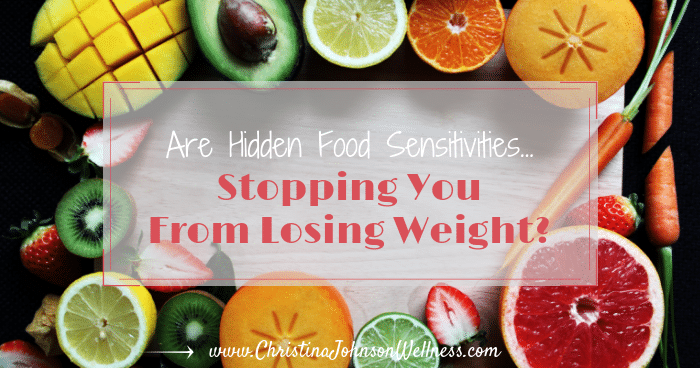Last Spring, I worked with 25 people whose primary goal was to lose weight. Most of them had tried several diets before and some even ate pretty healthy overall…but they still struggled to lose weight. On top of that, many of them also talked about the stiff and achy joints, stomach issues, and lack of energy that they noticed on a regular basis.
While there can be many reasons why it’s difficult for someone to lose weight, there’s a really common obstacle that’s often overlooked…food sensitivities.
Food sensitivities not only make it difficult to lose weight, but they also cause a variety of other symptoms that get in the way of feeling your best throughout the day.
But here’s the exciting news…once you identify your food sensitivities and stop eating those foods, you will begin to lose weight quickly and feel so much better! And that’s exactly what happened for the 25 people I led through a 21 Day Detox to identify and eliminate their food sensitivities. They were excited to find out how much better they could feel while still eating really good food!
So let’s take a look at what food sensitivities are and whether or not they’re making it difficult for you to lose weight.
What Are Food Sensitivities?
A food sensitivity, according to the American Academy of Allergy, Asthma, & Immunology, “occurs when a person has difficulty digesting a particular food”. This sensitivity triggers an IgG reaction, which is a delayed immune response.
In other words, when your body is sensitive to a particular food and you don’t digest it well, your immune system fires up in response. If you continue to eat that food you’re sensitive to, your immune system remains active, which leads to chronic inflammation throughout your body.
Before moving on, it’s important to note that a food sensitivity is different than a food allergy. An allergy usually leads to an immediate, severe, and potentially life-threatening reaction. A reaction to a food sensitivity is often less severe and can happen anywhere from moments after you eat that food up to 72 hours later. At that point, it can be difficult to determine which food from the past 72 hours is causing you a problem!
Inflammation
As mentioned, food sensitivities can lead to chronic inflammation when you repeatedly eat the food that you’re sensitive to. And inflammation, whether it’s caused by food sensitivities or by something else, is a major source of health issues. It can disrupt your hormones, create insulin resistance, interfere with your digestion, lead to fluid retention, and so much more! These factors alone create the perfect environment to gain weight and to not feel your best.
In fact, according to Mark Hyman, MD:
Inflammation is one of the biggest drivers of weight gain and disease in America.
And if that were not enough, a Harvard Medical School report asserts:
Chronic inflammation plays a central role in some of the most challenging diseases of our time, including rheumatoid arthritis, cancer, heart disease, diabetes, asthma, and even Alzheimer’s.
Take a moment to re-read that list of diseases linked to inflammation…it’s a pretty scary list! By doing everything you can to decrease levels of inflammation within your body, you’ll be massively improving your overall health and reducing your risk of disease in the future.
Common Signs of Food Sensitivities
Since it can take up to 72 hours to react to a food you’re sensitive to and because a sensitivity can produce such a wide variety of symptoms, many people have no idea that the issues they’re dealing with are caused by something they’re eating.
Here are a few common signs of food sensitivities:
- Difficulty losing weight
- Bloating
- Gas
- Stomach pain or nausea
- Joint pain
- Tiredness and fatigue
- Dry or itchy skin
- Acne
- Rashes
- Acid reflux
- Constipation or diarrhea
- Headaches or migraines
Many people accept with these symptoms as a “normal” part of life or of aging. However, once you figure out which foods cause you problems, these issues will start to disappear, and you’ll feel better than you have in a long time!
Top 9 Inflammatory Foods
In order to feel healthy, have lots of energy, and have an easier time losing weight, it’s important to determine which foods you might be sensitive to. What’s often surprising is that even though a food is classified as “healthy”, like bell peppers or eggs, it may not be healthy for YOU and your body.
Several well-known nutritionists and functional medicine practitioners (such as JJ Virgin, Mark Hyman, MD, and Amy Myers, MD) agree that certain foods are more likely to cause food sensitivities than other foods.
Here’s a list of 9 foods that are commonly known sources of food sensitivities or inflammation for many people:
- Gluten
- Dairy
- Corn
- Soy
- Nightshades (peppers, eggplant, white potatoes, etc)
- Peanuts
- Yeast
- Sugar
- Artificial Sweeteners
Other foods cause food sensitivities as well. But for most people, this list is a great place to start investigating what might be getting in the way of your health and weight loss goals.
How to Determine If You Have a Food Sensitivity
So how do you figure out which foods might be bothering you?
One of the best ways to figure this out is to follow an elimination protocol for 3 or 4 weeks. During this time, eliminate the 9 foods listed above that are known to be common sources of food sensitivities and inflammation. This gives your immune system a chance to relax, the levels of inflammation in your body decrease, and you’ll start to feel so much healthier overall!
Then, after 3-4 weeks of avoiding these 9 foods, slowly reintroduce them, one at a time, to determine which ones (if any) affect you negatively. This slow reintroduction is a great strategy to pinpoint which foods are making it difficult for you to lose weight, causing you joint pain, upsetting your stomach, and so on.
When you’re ready to reintroduce foods, choose 1 food and eat it 2-3 times a day for 3 days. Pay close attention to see if any of your old symptoms return. If they don’t return, you can assume that food works for your body. If any symptoms do come back, then you know that particular food bothers you.
After testing out 1 food for 3 days, you can move on to reintroduce another food. Continue to repeat this process until you have tested each of the 9 foods you eliminated.
The best part is that once you follow this process, you’ll have extremely valuable information on what foods support your health and which ones cause you problems. Then, it’s up to you to choose which foods you will continue eating, which ones you need to eat less often, and which ones you will avoid completely.
It’s so empowering to figure out exactly what foods are causing you to feel bloated, to feel tired in the afternoon, or to feel stiff and achy when you wake up. Because then, you can do something about it!
A Step-By-Step Process to Follow
If you’re feeling overwhelmed by the thought of going through this process on your own, I’ve designed a 21 Day Detox to take you through the process of eliminating the 9 most common inflammatory foods, step-by-step. The purpose of the detox is to help you identify which foods you may be sensitive to, to reduce the amount of harmful toxins you’re exposed to, and to support your body with a variety of healthy nutrients.
This process will help you reduce inflammation, and in just 21 days you’ll jumpstart weight loss, have more energy than you’ve had in a long time, and feel so much healthier!
These detoxes are offered once each season, so click here to join the waitlist so that you’re notified when the next detox will be offered. You’ll also receive special early bird pricing!
And, if you’re ready to do the detox NOW, simply email Christina at christina@christinajohnsonwellness.com. She’ll send you all the details and personally guide you through the detox!



